Klonopin (clonazepam): definition, uses, and side effects
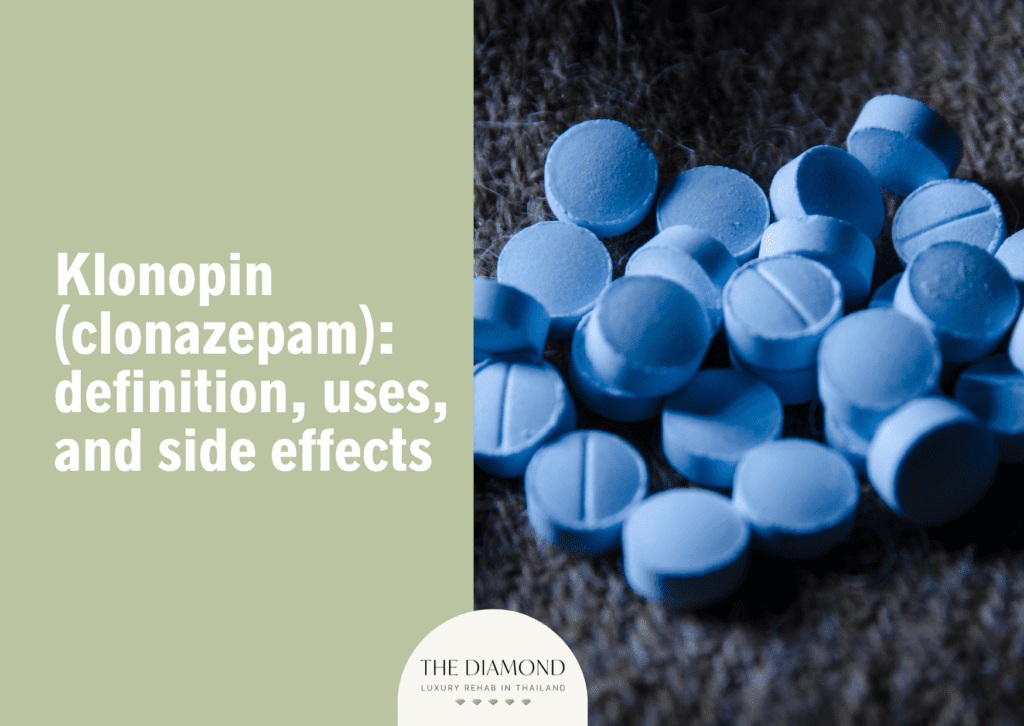
Klonopin, the brand name for clonazepam, is a prescription medication classified as a benzodiazepine. Used to treat anxiety, panic disorders, and seizures, the drug works by calming excessive brain activity.
The uses of Klonopin include the treatment of panic disorder, anxiety disorders, seizure disorders (epilepsy), sleep problems, muscle spasms, alcohol withdrawal, illness anxiety disorder, and depressive disorders.
The side effects of Klonopin include drowsiness, dizziness, fatigue, memory problems, confusion, coordination issues, mood changes, respiratory depression, and dependence.
What is Klonopin?
Klonopin is a prescription medication classified as a benzodiazepine. The prescription drug reduces excessive nerve activity by increasing GABA (gamma-aminobutyric acid) activity in the brain, thus producing a calming effect.
Common prescriptions for clonazepam among doctors are for conditions like seizures, panic disorders, and anxiety-related conditions. As a long-acting benzodiazepine, the effects of Klonopin last longer than those of short-acting alternatives, making the medicine useful for sustained symptom relief.
For individuals needing constant management over seizures or anxiety symptoms, the prolonged duration helps preserve stability. Though useful, the drug has a risk of dependence and withdrawal symptoms if taken improperly or for an extended period of time, necessitating close supervision from medical professionals.
What is the other term for Klonopin?
The other term for Klonopin is clonazepam, the generic name for the medicine. Klonopin serves as the brand name for clonazepam, while the generic version contains the same active ingredient without branding.
Both versions function identically, offering therapeutic effects for conditions like anxiety, panic disorders, and seizures. Healthcare providers prescribe either the brand-name or generic version, depending on factors like availability, cost, and patient preference.
Despite the differences in branding, both forms share the same chemical composition, dosage options, and potential side effects.
How common is Klonopin use?
Klonopin use is relatively common, as clonazepam accounted for 24% of the estimated 92 million benzodiazepine prescriptions filled by U.S. outpatient pharmacies in 2019 (second only to alprazolam’s 38%), according to a 2020 publication from the United States Food and Drug Administration (US FDA), titled “FDA Requiring Labeling Changes for Benzodiazepines.”
In a 2018 study by Sidorchuk et al., titled “Benzodiazepine prescribing for children, adolescents, and young adults from 2006 through 2013: A total population register linkage study,” 117,739 individuals aged 0–24 who had at least one BZD prescription between 2006 and 2013 (3.16% of the study population) received clonazepam.
What is Klonopin made of?
Klonopin is made of the active ingredient clonazepam, a chemical compound classified under the BDZ/BZD (benzodiazepine) category. The chemical structure of clonazepam enables binding to BDZ receptors, enhancing the calming effects of GABA.
Klonopin tablets additionally contain inactive ingredients including lactose, magnesium stearate, and cornstarch in addition to clonazepam. Active and inactive components taken together guarantees the drug’s potency and patient usability.
What are the uses of Klonopin?
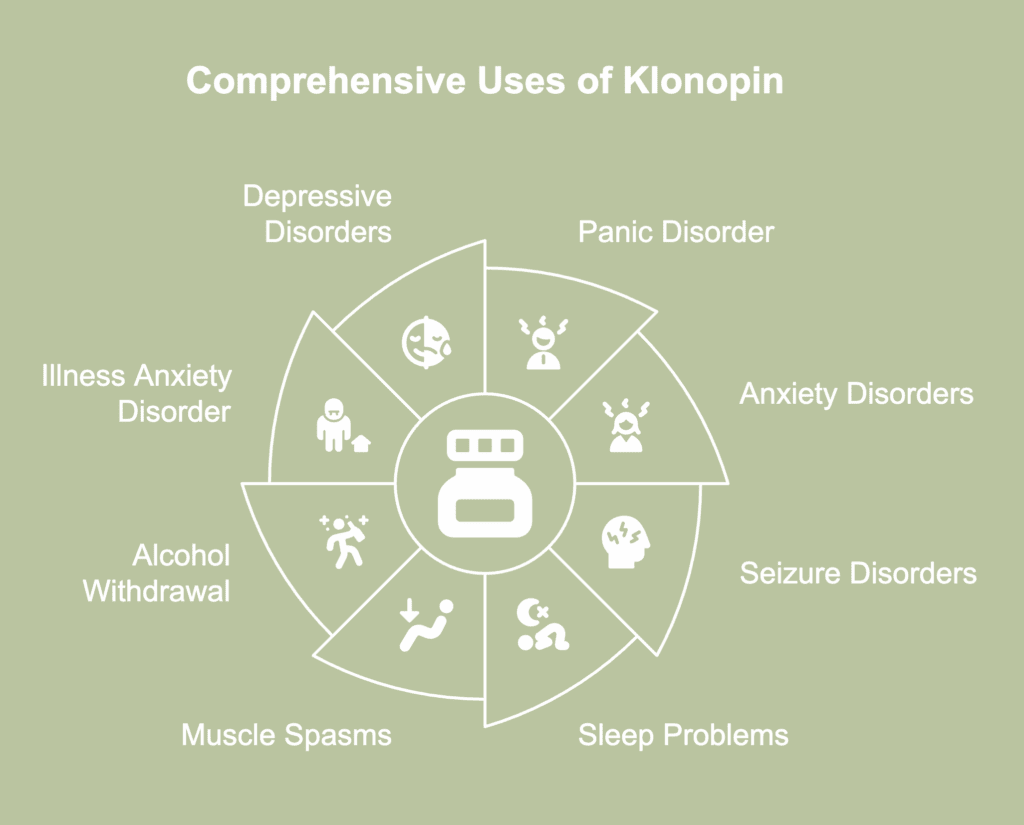
Uses of Klonopin refer to the various medical conditions for which Klonopin (clonazepam) is prescribed. The uses of Klonopin are listed below.
- Panic disorder: Klonopin helps reduce the intensity and frequency of panic attacks in panic disorder. Through enhancing GABA activity, the drug calms overactive brain signals triggering the sudden, intense feelings of fear and dread associated with panic attacks. People feel more at ease and safe as a result, reducing the likelihood of an attack.
- Anxiety disorders: Through reducing hyperactive brain circuits connected with stress reactions, Klonopin’s sedative qualities help regulate high levels of anxiety. Since it promotes relaxation and reduces intrusive anxious thoughts, clonazepam is particularly helpful in treating social anxiety and generalized anxiety disorder. The medicine additionally assists with physical anxiety symptoms including fast heart rate and muscle tension. While effective in the short term, Klonopin is often paired with therapy for long-term management.
- Seizure disorders (epilepsy): As an anticonvulsant, Klonopin stabilizes the electrical activity in the brain, preventing seizures. A major cause of seizures, excessive neuron activity, is inhibited by the drug. For more than 40 years, clonazepam has been used to treat a variety of epilepsy types, including myoclonic seizures, absence seizures, and severe infantile epilepsy disorders including Lennox-Gastaut syndrome, as per a 2022 report by Kienitz et al., titled “Benzodiazepines in the Management of Seizures and Status Epilepticus: A Review of Routes of Delivery, Pharmacokinetics, Efficacy, and Tolerability.”
- Sleep problems: Klonopin is used off-label for certain sleep disorders, like REM sleep behavior disorder, by calming muscle movements during sleep. The drug suppresses brain activity causing disruptive nighttime behaviors, improving sleep quality. Additionally, the sedative effect helps individuals fall asleep faster and stay asleep longer. However, clonazepam is not a first-line treatment for insomnia due to risks of dependence and daytime drowsiness.
- Muscle spasms: Klonopin assists in reducing muscle spasms by relaxing the overactivity of the neurological system resulting in involuntary muscle contractions. The medicine proves useful for conditions such as muscle spasms caused by neurological problems or injuries. A 2021 study by Akita et al., titled “Clonazepam for pain due to muscle spasm in a patient with vertebral compression fractures caused by multiple myeloma: a case report” revealed how clonazepam proved to be highly effective in alleviating severe breakthrough low back pain resulting from vertebral compression fractures (VCFs) associated with multiple myeloma. The medication functioned as both a muscle relaxant and anxiolytic, mitigating the patient’s pain related to muscular spasms and anxiety due to the disease.
- Alcohol withdrawal: Alcohol withdrawal symptoms like agitation, tremors, and anxiety are treated with Klonopin. Withdrawal symptoms, both mental and physical, are lessened by the medicine’s ability to calm the nervous system. Reducing these symptoms helps lower the risk of more severe withdrawal effects, such as seizures, during detoxification. Klonopin is typically used as part of a comprehensive alcohol detox plan, under close medical supervision.
- Illness anxiety disorder: Through relaxing the nervous system and lowering excessive concern about one’s health, clonazepam aids in the management of illness anxiety disorder. The alleviation of anxieties enables patients to concentrate less on perceived medical concerns and attain enhanced emotional stability. Temporary use under medical oversight aids in preventing dependence while alleviating intense health-related fears.
- Depressive disorders: Clonazepam is sometimes used to manage symptoms of depressive disorders, particularly when accompanied by anxiety or agitation. As per a 2009 review by Shigeru Morishita, titled “Clonazepam as a therapeutic adjunct to improve the management of depression: a brief review,” clonazepam has demonstrated swift and efficacious outcomes when incorporated with common antidepressants in treatment-resistant or protracted instances of depression.
Who should use Klonopin?
Klonopin should be used by individuals with seizure disorders, panic disorder, generalized anxiety disorder, alcohol withdrawal symptoms, anxiety-related insomnia, muscle spasms, illness anxiety disorder, and depressive disorders.
People with seizure disorders rely on the medication to stabilize brain activity and prevent excessive neuron firing responsible for triggering seizures. Patients diagnosed with panic disorder experience fewer and less intense panic attacks due to Klonopin’s ability to enhance GABA activity and promote relaxation.
Individuals with generalized anxiety disorder use clonazepam to manage persistent nervousness and excessive worry, leading to greater emotional stability. People in recovery undergoing alcohol withdrawal benefit from Klonopin’s calming effects, easing agitation, tremors, and anxiety while lowering the risk of severe complications like seizures.
Since the drug encourages relaxation and permits longer, undisturbed sleep, people with anxiety-related insomnia enjoy better quality sleep. Patients diagnosed with muscle spasms due to neurological disorders or injuries find relief as Klonopin helps control involuntary contractions by calming the nervous system.
Lastly, the medication is occasionally used to treat the symptoms of anxiety and depressive disorders, where anxiety significantly exacerbates their condition.
Who should not use Klonopin?
Klonopin should not be used by individuals with allergic reactions to clonazepam or other benzodiazepines, patients with liver disease, people with a history of substance abuse or addiction, and pregnant or breastfeeding individuals.
Individuals with a history of hypersensitivity or allergic reactions to clonazepam or other benzodiazepines need to avoid Klonopin, as usage is likely to trigger severe adverse reactions. Patients with significant liver disease, particularly severe hepatic impairment, must avoid use as well because the medication is metabolized in the liver and leads to toxicity.
Persons with lung conditions such as chronic obstructive pulmonary disease (COPD) or severe respiratory disorders must avoid Klonopin because the medication poses a risk of respiratory depression. Individuals with kidney disease struggle to eliminate the drug from the body, leading to a higher likelihood of accumulation and toxicity.
People with a history of substance abuse or addiction are discouraged from using Klonopin, given the drug’s potential for dependence and misuse. Pregnant or breastfeeding individuals must avoid the drug unless deemed absolutely necessary by a healthcare provider, as clonazepam has the potential to harm the developing fetus or infant.
How is Klonopin used?
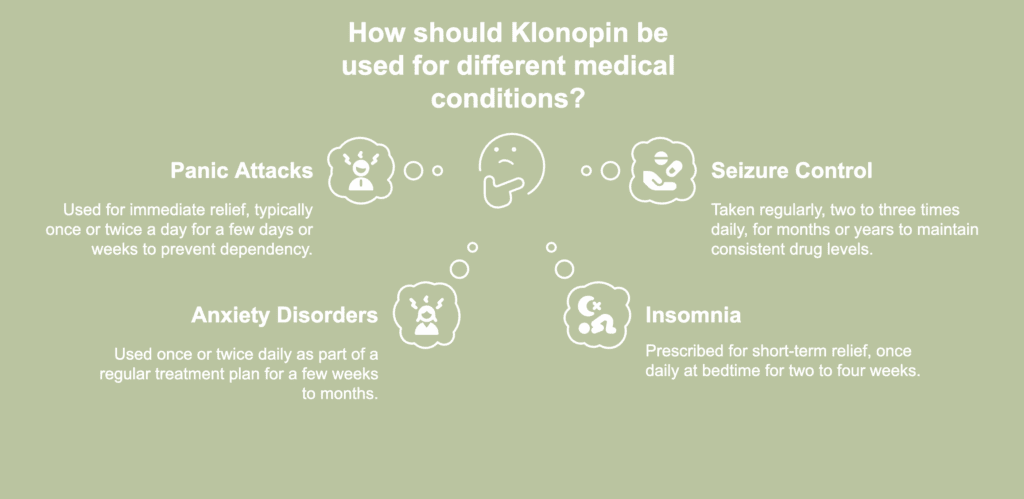
The ways on how Klonopin is used refer to the specific methods and guidelines for administering the drug to manage various medical conditions. The ways on how Klonopin is used are listed below.
- Once or twice a day for panic attacks: Klonopin is often prescribed for immediate relief during acute panic attacks. The medication is usually taken on an as-needed basis, typically no more than one or two doses in a single day. Such a short-term approach lasts only a few days or weeks to prevent dependency. The goal is to manage sudden symptoms while transitioning to long-term therapies.
- One to three times a day for seizure control: For seizure disorders, Klonopin is taken regularly throughout the day (two or three times daily) to maintain consistent levels of the drug in the body and prevent seizures. Treatment typically extends for months or even years, depending on the condition’s severity and control.
- Once or twice daily for anxiety disorders: For chronic anxiety disorders, Klonopin is taken once or twice daily as part of a regular treatment plan. The therapy typically lasts a few weeks to a few months, depending on the patient’s response and medical guidance. The dosage starts low and is adjusted as needed to balance symptom control and minimize side effects.
- Short-term use for insomnia: Klonopin is sometimes prescribed for short-term relief of insomnia. The drug is typically used for no longer than two to four weeks due to the risk of tolerance and dependence. The medication is taken at bedtime, once daily. This approach aims to stabilize sleep patterns temporarily while addressing the underlying issues.
- Once or twice a day for muscle spasms: Typically taken once or twice daily, Klonopin is often used on a short-term or as-needed basis, depending on the severity of the spasms. The medication helps relax muscles by calming overactive nerve signals.
- Short-term use during alcohol withdrawal: Klonopin is administered in controlled doses during alcohol withdrawal to ease symptoms such as tremors, anxiety, and agitation. Doctors carefully adjust the dosage based on withdrawal severity to prevent complications like seizures. Treatment usually lasts for a short period to avoid dependence on the medication. Close monitoring ensures safe detoxification while minimizing withdrawal-related distress.
What are the recommended Klonopin dosages?
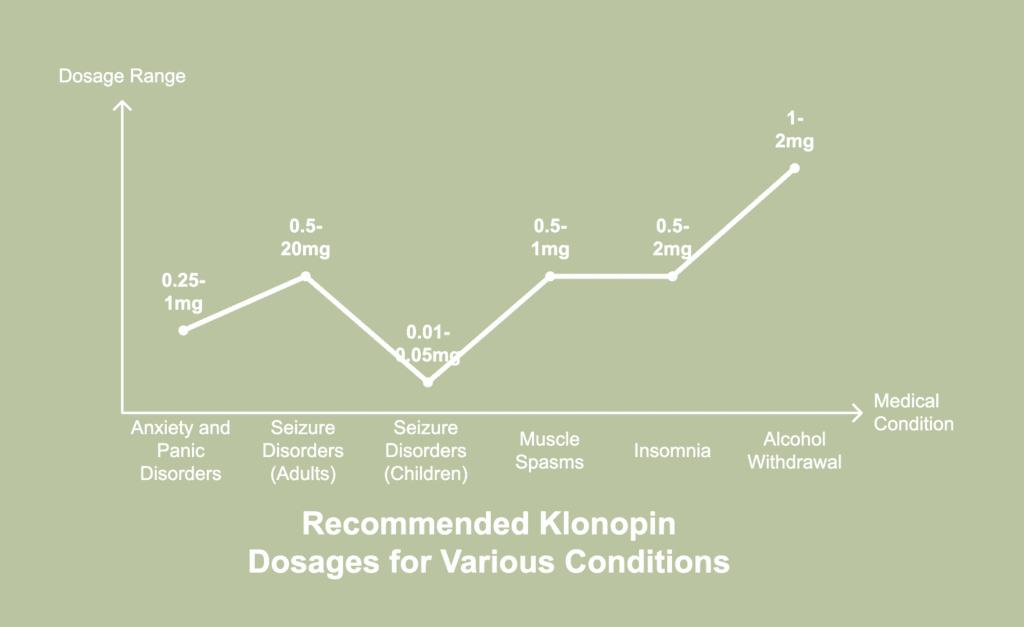
Recommended Klonopin dosages describe the prescribed amounts of Klonopin (clonazepam) tailored to treat specific medical conditions while minimizing risks of side effects or dependency. The recommended Klonopin dosages are listed below.
- 0.25 mg to 1 mg (anxiety and panic disorders): For adults, the initial dose starts at 0.25 mg twice daily and is sometimes increased to a maintenance dose ranging from 1 mg to 4 mg per day, divided into two or three doses, according to a publication by Hajira Basit and Chadi I. Kahwaji titled “Clonazepam,” last updated in May 2023. Gradual adjustments allow effective control of symptoms while reducing side effects. The approach ensures symptom relief without overwhelming the body with the medication.
- 0.5 mg to 20 mg (seizure disorders): Adults and children over ten years typically begin with 0.5 mg taken three times daily, gradually increased by 0.5 mg to 1 mg every three days. The maximum recommended daily dose is 20 mg, divided across the day for consistent therapeutic effects.
- 0.01 to 0.05 mg/kg (children with seizure disorders): Children under ten years or weighing less than 30 kg start with 0.01 to 0.03 mg per kilogram per day, divided into two or three doses. The dose is increased cautiously without exceeding 0.05 mg/kg/day to minimize the risk of adverse effects. Careful monitoring ensures safety and effectiveness for younger patients.
- 0.5 mg to 1 mg (muscle spasms): The initial dosage for muscle spasms ranges from 0.5 mg to 1 mg per day, divided into two or three doses. The dose is adjusted based on the severity of the condition and patient tolerance. Regular follow-ups are critical to ensure the treatment remains effective and minimizes side effects.
- 0.5 mg to 2 mg (insomnia): For managing insomnia, a single dose of 0.5 mg to 2 mg is taken at bedtime to promote relaxation and improve sleep quality. The dosage helps individuals fall asleep more easily and maintain restful sleep throughout the night. Treatment is generally short-term, lasting no longer than two to four weeks, to avoid dependency or tolerance.
- 1 to 2 mg (alcohol withdrawal): Although not FDA-approved for alcohol withdrawal, Klonopin is prescribed off-label at 1–2 mg per day, divided into 2–3 doses. The dosage is gradually reduced over several days to prevent dependence. Medical supervision is essential to avoid complications such as respiratory depression. The goal is to ease withdrawal symptoms while preventing severe reactions like seizures.
What are the precautions when using Klonopin?

Precautions when using Klonopin refer to the specific measures and considerations individuals must follow to ensure the medication is used safely and effectively. The precautions when using Klonopin are listed below.
- Inform healthcare providers of medical history: Before using Klonopin, patients must disclose any history of liver disease, glaucoma, or respiratory conditions to the healthcare provider. The previously mentioned medical conditions affect the metabolism or tolerance of the medication, thereby requiring adjustments to the dosage or the exploration of alternative treatment options. Giving a thorough medical history enables safe and suitable prescriptions.
- Avoid alcohol consumption: Combining Klonopin with alcohol enhances sedative effects, increasing the risk of severe drowsiness, respiratory depression, or accidents. Patients must avoid drinking alcohol while taking the drug to prevent potentially dangerous interactions.
- Monitor for dependency risks: Klonopin is habit forming, especially with long-term use or misuse. Patients need to use the medicine exactly as prescribed and report any signs of cravings or withdrawal symptoms to a healthcare provider. Regular evaluations help prevent misuse and ensure responsible medication use.
- Avoid operating machinery or driving: Klonopin increases the risk of accidents by causing drowsiness, dizziness, and decreased coordination. Until the effects of the medicine are known, patients must refrain from operating heavy machinery or driving. Taking such measures reduces the dangers to the patient and other people.
- Inform about pregnancy or breastfeeding: Women who are pregnant, planning to conceive, or breastfeeding need to inform the doctor, as Klonopin harms the fetus or passes into breast milk. The medication is used in such situations strictly when absolutely necessary and under close medical supervision.
- Avoid abrupt discontinuation: Stopping Klonopin suddenly leads to withdrawal symptoms, such as anxiety, seizures, or tremors. Patients must follow a healthcare provider’s tapering plan to gradually reduce the dose when discontinuing. The method prevents complications and ensures a safer transition off the medication.
What is the best time to take Klonopin?
The best time to take Klonopin depends on the condition being treated and the dosing schedule prescribed by a healthcare provider. For anxiety or panic disorders, Klonopin is often taken in the morning and/or evening at roughly the same time every day to keep the drug at consistent levels in the body throughout the day.
For conditions like insomnia, the medication is typically taken 30 minutes before bedtime to help induce sleep. When prescribed for seizures, doses are usually spaced evenly across the day to ensure stable control of seizure activity.
Regardless of the condition, Klonopin must be taken at the same time(s) daily to maximize effectiveness and minimize side effects like drowsiness during waking hours.
How long does it take for Klonopin to start working?
It takes around 20 to 60 minutes for Klonopin to start working. Relieving anxiety, panic attacks, or seizures, the drug’s effects peak one to four hours later.
For conditions like seizures or muscle spasms, the calming effects begin relatively quickly as well, providing relief within the same time frame. However, the full therapeutic effect, especially for chronic conditions such as anxiety disorders, takes several days to a few weeks of regular use as the medication builds up in the body.
The onset of action varies based on factors like dosage, individual metabolism, and whether the drug is taken with or without food.
Is a prescription required for Klonopin?
Yes, a prescription is required for Klonopin. As a controlled substance classified under Schedule IV in the United States, Klonopin is regulated due to the potential for misuse, dependency, and side effects.
A doctor’s prescription ensures the drug is used appropriately and solely for approved medical conditions. Healthcare providers assess a patient’s medical history, symptoms, and potential risks before prescribing Klonopin. Without a doctor’s prescription, obtaining the medication is illegal and unsafe.
Unauthorized use increases the likelihood of adverse effects, drug interactions, and dependency. Pharmacies dispense Klonopin to individuals with a valid prescription to prevent misuse. Stringent regulations guarantee appropriate medical care while shielding patients from accidental harm.
What are the side effects of Klonopin?
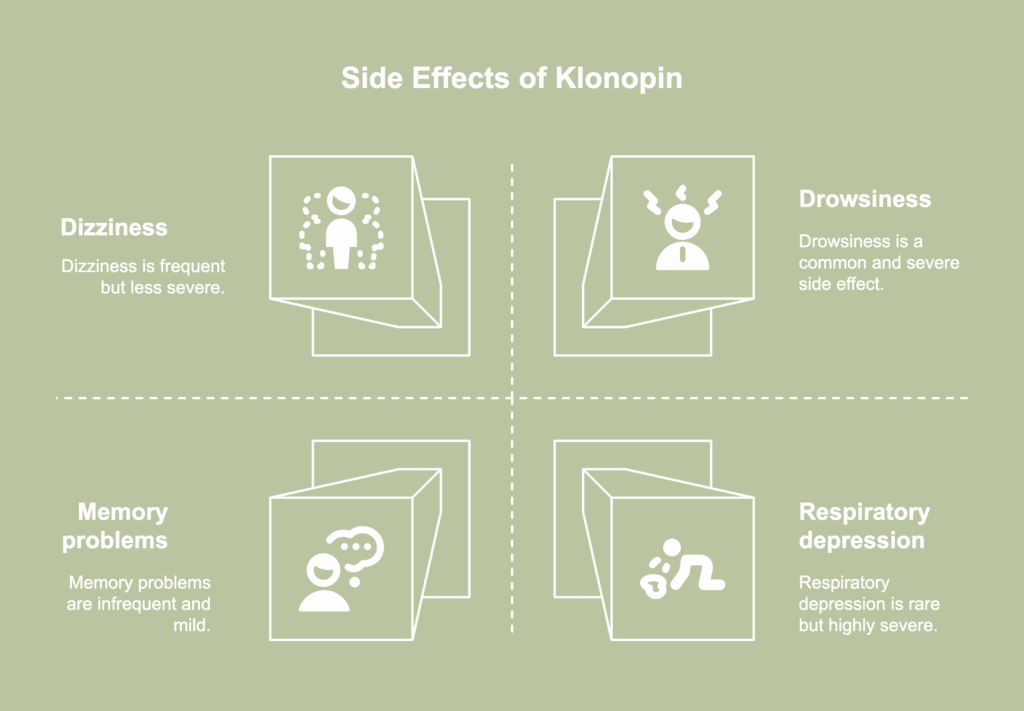
Side effects of Klonopin refer to the unintended adverse reactions occurring when taking the medication. The side effects of Klonopin are listed below.
- Drowsiness: Drowsiness is a common side effect because the medication’s sedative properties are designed to relax the nervous system. The reduction in brain activity resulting from the process leads to drowsiness, particularly when starting the medication or after a dose increase.
- Dizziness: Klonopin disrupts the brain’s balance-regulating mechanisms, leading to dizziness. The effect is more noticeable when standing up quickly or during physical activity. The calming effects responsible for reducing anxiety or seizures inadvertently impair equilibrium. Staying hydrated and avoiding sudden movements help manage dizziness as a side effect.
- Fatigue: Fatigue occurs as a side effect of Klonopin due to sedative properties slowing down nervous system activity. As the body adjusts to the medication, fatigue may lessen over time, especially with gradual dosage adjustments. However, persistent or excessive tiredness requires consultation with a healthcare provider to evaluate the dosage or explore alternative treatments.
- Memory problems: Klonopin affects areas of the brain responsible for forming and retrieving memories, such as the hippocampus. Through slowing neural communication, clonazepam impairs short-term memory, making retention of new information more challenging. Such effects are common with medications acting on the central nervous system.
- Confusion: The brain’s slower processing speed caused by clonazepam leads to confusion or difficulty concentrating. The side effect occurs as a result of the medication’s impact on neurotransmitters and overall brain function. Confusion is more likely with higher doses or in individuals sensitive to the drug’s effects.
- Coordination issues: Klonopin impairs balance and motor control, resulting in clumsiness or unstable movements. The medicine reduces control and precision by slowing down the impulses going from the brain to the muscles. Problems with coordination are especially problematic when driving or operating machines.
- Mood changes: Klonopin’s effect on brain chemistry disrupts mood regulation, potentially leading to feelings of sadness or irritability. While calming overactive brain activity, the dampening effect reduces overall stimulation needed for positive emotional responses. Preexisting mental health conditions exacerbate the side effect.
- Respiratory depression: Klonopin slows down brain signals controlling breathing, resulting in shallow or slowed respiration, especially at high doses. A 2012 paper by Channing et al., titled “Respiratory arrest and oversedation in an adolescent given intramuscular clonazepam for rapid tranquillization” featured a 14-year-old girl’s case highlighting the dangers of excessive sedation. The described case involved severe sedation leading to respiratory depression and necessitated emergency intervention.
- Dependence: Prolonged use of Klonopin leads to physical or psychological dependence because of the medication’s impact on brain chemistry. The brain adapts to the calming influence of the BZD, creating a need for ongoing use to sustain balance. Suddenly discontinuing the drug results in withdrawal symptoms, making the process more difficult without medical support. A controlled tapering schedule is essential to manage dependence safely.

